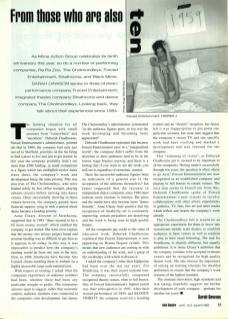The funding situation for all companies began with small amounts from ‘somewhere’ and ‘anywhere’. Deborah Chadbourne, Forced Entertainment's administrator, pointed out that in 1984, the company had only just moved to Sheffield, priorities on the list being to find a place to live and just to get started. In this year the company probably didn't see more than £500 funding (a small comparison to a figure which has multiplied twelve times since then), the company's work and development being the main priority. This was also true of The Cholmondeleys, who were funded solely by box office receipts, playing cabaret circuits before moving into dance venues. Once successfully showing in these venues, however, the company gained more financial support, tying in with a period where dance became a funding priority.
Anne Cleary, director of Strathcona, suggested that in 1984 ‘there seemed to be a bit more money around’ which enabled the company to get started. She went on to explain that the money was always project based and revenue funding was as difficult to get then as it appears to be today. In this way it was impossible to predict how the company's funding would be from one year to the next. Now, in 1994, Strathcona have become Arts Council clients enabling them to embark on a highly successful, large-scale national tour.
With respect to touring, I asked what the companies’ experiences of audience numbers had been, whether there had been any particular troughs or peaks. The companies’ answers seem to suggest, rather than economic context, audience numbers were connected to the companies own development. Ian James, The Cholmondeleys's administrator, commented that ‘as the audience figures grew, so too was the work developing and becoming more appreciated’.
Deborah Chadbourne explained that because Forced Entertainment exist in a ‘marginalised world’, the company didn't suffer from the recession as their audiences tend to be in the lowest wage bracket anyway, and there is a feeling that if you want to see the work, you will see it, regardless of economic context.
Have the successful audience figures been an indication of a general rise in the acceptance of the artforms themselves? Ian James suggested that the increase in independent dance companies since 1984 must indicate some increase in interest. The press and the media have also become more ‘dance friendly’. Anne Cleary feels positive that the acceptance of disability art is constantly improving, certain prejudices are dissolving and the work is being seen as high quality theatre.
All the companies pay credit to the value of education work. Deborah Chadbourne explained that Forced Entertainment is now appearing on Drama Degree syllabi. This means that new audiences are coming in with an understanding of the work, and a grasp of the vocabulary with which to discuss it.
I asked the companies what their high-points had been over the last ten years. For Strathcona, it was their recent national tour. The company successfully conquered recognised theatre venues, often playing to full houses. One of Forced Entertainment's highest points was their retrospective in 1991. After their second performance of 200% and Bloody Thirsty the company received a standing ovation and an ‘electric’ reception. Ian James felt it was inappropriate to pinpoint one particular moment, but went on to suggest that the company's recent TV and site-specific work had been exciting and marked a development and way forward for the company.
This ‘widening of vision’, as Deborah Chadbourne put it, seemed to be important to all the companies. Having made it successfully through ten years, the question is often where to go next? Forced Entertainment are now recognised as an established company and playing to full houses in circuit venues. The next step seems to branch out from this. Deborah Chadbourne spoke of Forced Entertainment's new visions to involve collaborations with other artists, experiments in galleries, TV, film, fine art, and other media which reflect and inspire the company's work already.
The Cholmondeleys felt it would be an appropriate experiment for them to move into mainstream middle-scale theatre, to establish audiences in these venues as well as continue to play to their usual following. The task for Strathcona is slightly different, but equally ambitious. It is Anne Cleary's ambition that the company continue to be accepted in theatre venues and be recognised for high quality theatre work. She also stresses the importance of setting up training schemes for disabled performers to ensure that the company's work remains of the highest standard.
The constant innovation, high standards and risk taking, hopefully suggests the further development of each company – perhaps for another ten years!

